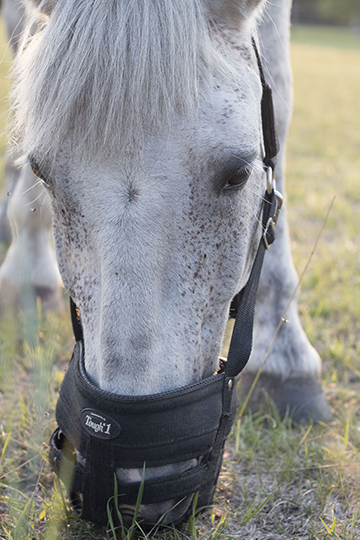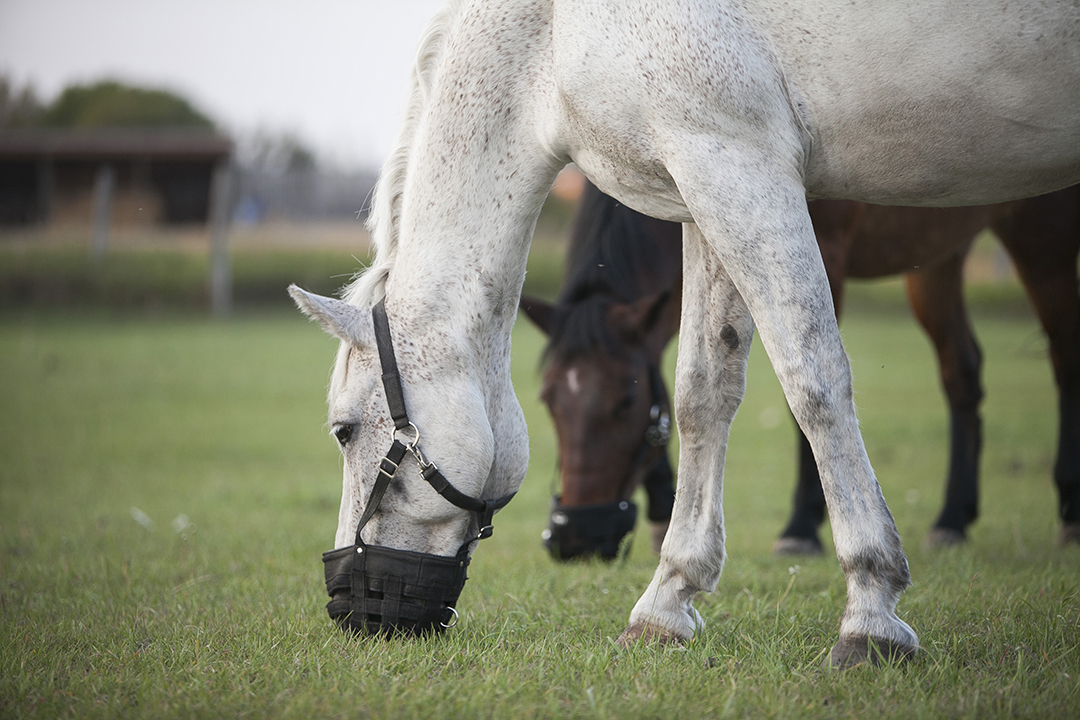
When the tractor comes along, your role on the farm changes. There’s less work for you to do, but you still get your daily grain ration. It’s rich in carbohydrates and you love it, but you’re not getting as much exercise as you used to and now there’s fat gathering in your neck and along your back. It builds up in your shoulders and over your ribcage. There’s additional pressure on your joints and your hoofs start to feel like they are being torn apart from the inside.
You have laminitis, a condition where the tissues holding the hoof together become inflamed and start to fail.
“Most horses used to be working horses,” says Dr. Julia Montgomery, assistant professor of large animal medicine at the Western College of Veterinary Medicine (WCVM). “Especially in this province [Saskatchewan] — probably every horse that used to exist in this province 50 or 80 years ago was a work horse. If you pull a plow all day you need to eat oats.”
Recently, WCVM researchers conducted a retrospective study of horses that were part of the WCVM’s field service caseload. The study’s results showed that on average, Saskatoon-area horses weigh slightly higher than ideal, says WCVM field service veterinarian Dr. Kate Robinson, who also led the research project.
Most veterinarians evaluate horses using the Henneke equine body condition scoring system that’s featured in Canada’s Code of Practice for the Care and Handling of Equines. The scoring scale ranges from one to nine, one being extremely thin (emaciated) and nine being extremely overweight (bulging fat). The ideal body condition score for a horse is around five.
For the 290 horses included in the WCVM study, the average body condition score was six.
“It’s not uncommon when we chat with clients that they are actually unaware of the fact that their animal is overweight,” says Montgomery. “We do see a lot of horses that are in fantastic shape. The horses that we do see that are overweight are much loved and cared for. It’s a matter of perception and awareness.”
While a diet rich in grain makes sense for horses that live active lifestyles and get a lot of exercise, concentrate feeds are high in calories and can be too much for some horses. Montgomery says that there are two potential factors at work here: a horse is either being fed more than it needs, or they have a different metabolism.
“You could have two horses on your property. They’re the same size and you feed them the same diet, they do the same amount of work. But one horse burns off the energy just fine, and the other horse might have problems with its insulin metabolism and might not be able to handle that kind of carbohydrate load.”
This condition is known as equine metabolic syndrome (EMS). This endocrine disorder is similar to type 2 diabetes in people where insulin doesn’t regulate blood sugar levels the way it’s supposed to. Because EMS presents more often in hardy horse breeds, one theory about the disease’s cause is a discrepancy between the types of feed a horse’s metabolism has evolved to absorb and the types of feed that a horse is eating in a stall.
“The Shetland pony is a great example,” says Montgomery. “It [the breed] comes from the Shetland Islands. There’s not much around. If you take an animal that’s evolved to live off of what’s around them, and you put them in a lush pasture or you feed them a bunch of grain, they just can’t handle that.”
Most horses don’t need much more than grass or hay to stay happy and healthy. But the trouble with lush, green pastures is the high sugar content of the grass.
“Depending on the growing conditions, the time of year and even day to day – the amount of sugar and calories in grass can vary,” says Robinson. “If you turn a horse out on pasture, it essentially is eating at a 24/7 buffet.”
Grasses are richest in the spring, and the plants feed off sunlight to build up sugars throughout the day. While sugars in grasses tend to be lowest between 6 a.m. and 10 a.m., Robinson cautions that the situation isn’t always so cut and dry. If temperatures drop below five degrees at night, grass goes into a mini-hibernation and will not use up the sugar it gathered during the day — meaning that the grass plants could be just as rich in sugar content at 6 a.m. as they are during the afternoon.
Heavy rainfall, stress from drought conditions or overgrazing can also increase sugar content in grasses.
In addition to regulating horses’ grazing times, owners have other options to regulate horses’ eating and exercise when they’re on pasture. Muzzles make it possible for horses to drink water and to graze without over-eating. Owners can also enrich their horse’s environment by installing fences and creating obstacles in pastures that horses must walk through or go around. This trademarked Paddock Paradise concept is designed to simulate a horse’s natural habitat and to keep them moving.
“If an owner has control over their horse’s diet and wants to manage their horse’s weight, it can be helpful to weigh out their feed,” says Robinson. “The average horse should do pretty well on two per cent of its bodyweight in hay [during] every 24-hour period. Actually knowing how much a horse is fed on a daily basis is important.”
Alternatively, providing small, frequent meals in slow feeder nets is a good way to limit the amount of food a horse eats while still catering to the horse’s natural instinct to constantly graze. If a horse is able to exercise, Robinson recommends 30 to 60 minutes of exercise four to five times per week to maintain good body condition.
Like people, horses can come in many different shapes and sizes, colours and personalities. And just like humans, weight issues in horses create a number of different health concerns. Overweight horses are more likely to develop arthritis when they’re older, more likely to be affected by laminitis and more likely to develop EMS. It can also be difficult for overweight mares to conceive.
“Overall we see a trend toward more overweight pets — and we see that in small animals as well as horses,” says Montgomery. “Owner education is key.”
Kyrsten Stringer of Wolseley, Sask., is a Master of Journalism student at the University of Regina. She was a communications intern at the WCVM during the summer of 2017.
Visit tehrf.ca to read more stories in the Fall 2017 issue of Horse Health Lines, news publication for the WCVM's Townsend Equine Health Research Fund.
